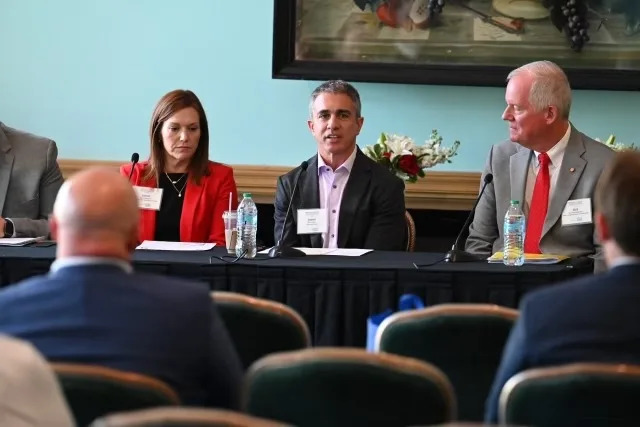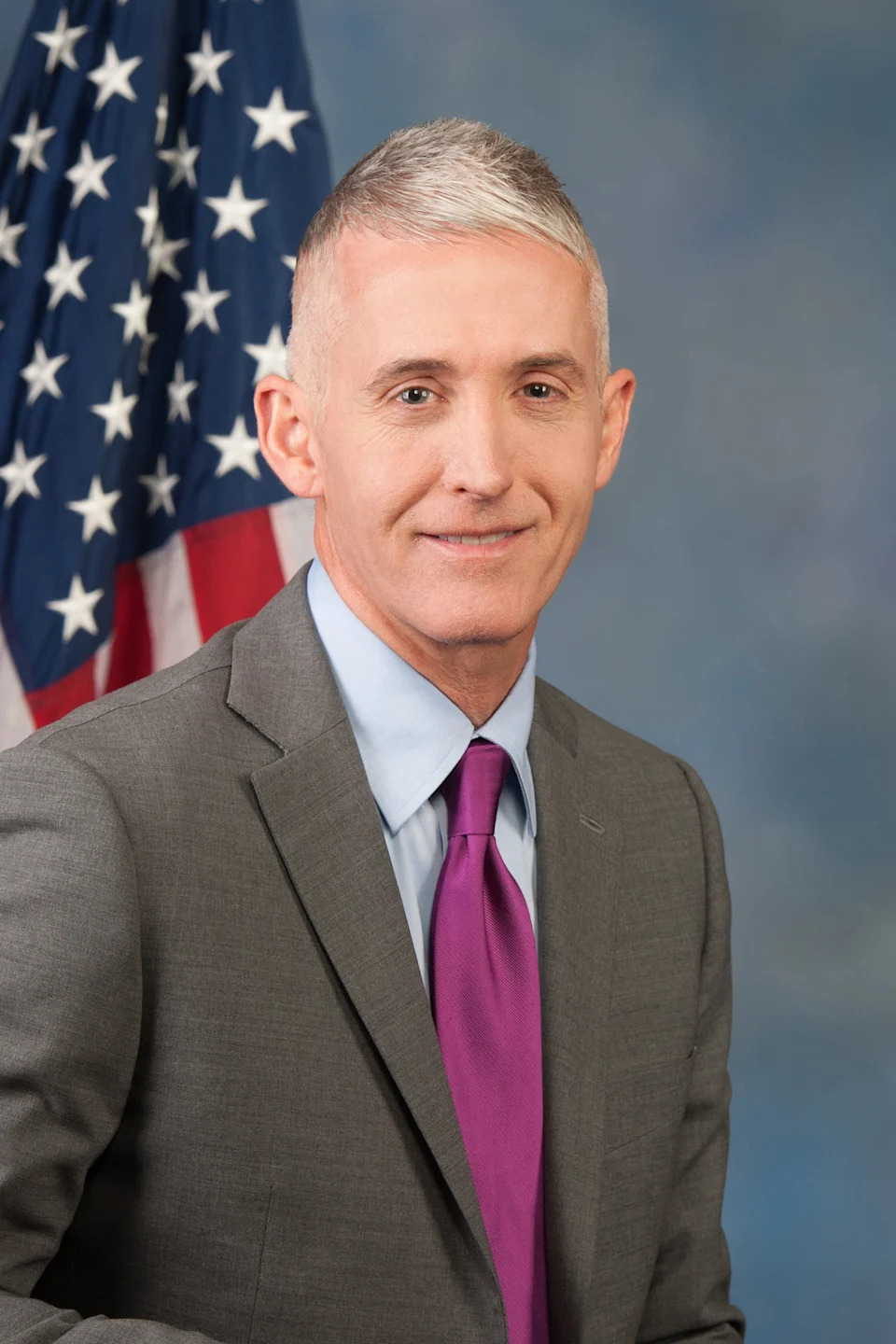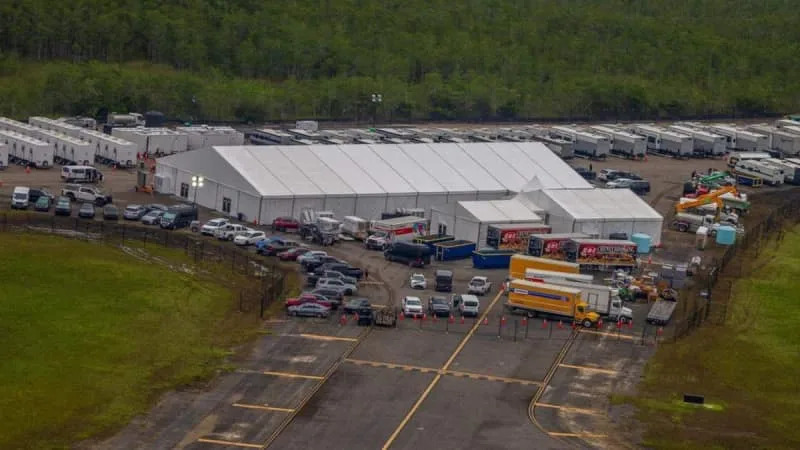
Sarah Bolyard, president and CEO of YMCA of the Kanawha Valley, Jason Moss, head of new government initiatives for Wonderschool, and Del. Bob Fehrenbacher, R-Wood, speak on a panel about child care at the West Virginia Chamber of Commerce’s Annual Business Summit at The Greenbrier on Wednesday, Aug. 27, 2025. (Alex Wilson/Courtesy photo)
WHITE SULPHUR SPRINGS, W.Va. — West Virginia continues to be woefully short on child care: multiple counties don’t have a single child care provider, and other counties have limited spots.
Child care providers are struggling to stay afloat, and parents have to grapple with the price tag. The average cost of child care in West Virginia is about $800 per month for one child, according to research from the West Virginia Chamber of Commerce.
Meanwhile, there’s been little to no action from state lawmakers or the governor on the issue as more than 150 child care providers have closed their doors over the last few years.
The issue was highlighted at the chamber’s annual Business Summit, which continues this week at The Greenbrier resort in White Sulphur Springs. Panelists laid out challenges and potential solutions at the discussion, linking the problem to the state’s low workforce participation rate.
“It’s been one of the things that we’ve been focused on in the legislature for several years now, trying to move the ball forward,” said Brian Dayton, vice president of policy and advocacy for the West Virginia Chamber of Commerce. He noted that Toyota Manufacturing in Putnam County recently announced they’ll open a child care facility for 240 children by 2027.
“But that’s not enough. We’ve got to be doing some other things,” Dayton said.
Sarah Bolyard is president and CEO of YMCA of the Kanawha Valley, which operates a child care facility in Cross Lanes that serves around 300 children ages six weeks to 12. Like many child care facilities in West Virginia, Bolyard’s program takes children using the state’s income-based child care subsidy program or parents who are working or in school.
“At our Cross Lanes YMCA child care facility, we lost $147,000 last year,” she said, explaining that the centers have to stay open with the correct staff ratio every day. “We do lose money to the state when we take children that are on subsidy. And, so that’s where the challenge lies.”
She continued, “It is expensive for a family, but as a provider, we are still losing significant amounts of money every year to be able to operate.
Jason Moss, head of new government initiatives at Wonderschool, said the tech company is trying to address the affordability challenges in West Virginia. Wonderschool operates in a dozen states around the country.
“What started in Michigan as a pilot in three counties, is now statewide. It saved $8.5 million in tuition,” Moss said.
The state recently rolled out its tri-share program, operated by Wonderschool, which divides the cost of child care among the employer, the employee and the state. It’s currently piloted in eight counties: Boone, Jackson, Kanawha, Lincoln, Mason, Putnam, Roane and Wirt.
Recently, Roane General Hospital became the first hospital to join the state’s tri-share model initiative.
Moss said his company’s research showed that about half of West Virginia businesses interviewed said child care challenges frequently or very frequently affected their employees’ ability to work.
“The other thing that was sort of interesting that came out of this is that 70% said they were currently not doing anything to support those child care challenges,” he added. “[Tri-share] is one of many solutions, but this is something that really, right now, we can get a lot of traction in to start to help to address this.”
Child care bills stalling out at the statehouse
This year, lawmakers passed zero legislation focused on improving child care in the state. A similar thing happened in 2024.
“’We’re still struggling to get some traction in the legislature,” Dayton said.
There were a number of child care measures introduced this year, particularly in the House, that never made it to up for a vote. One bill would have required the state to partner with child care employers to offset their employees’ child care costs. The program is meant to help centers retain workers and keep classrooms open.
“Frankly, not a lot of traction on it yet,” said Del. Bob Fehrenbacher, R-Wood, who spoke on the panel and introduced child-care bills during the most recent legislative session.
“There are multiple reasons why I think this is wise for our state. And, if we were to look at it on a macro level, I think $1 spent on childcare will be well spent and the benefit to West Virginia,” he added.
Most of the child care bills require state dollars, which contributed to their failure due to budget constraints.
The state Chamber of Commerce has pushed for child care changes, including taking the tri-share program statewide and expanding tax credits for employer-sponsored child care.
Boyles proposed updating the state’s “archaic billing” system, as she described it, for parents using West Virginia’s child care subsidy program. Her center bills the state for children based on the days they attend then reduces the parent’s portion of the price. It’s currently based on an hourly increment, but she said they need to be able to bill on a true daily rate.
“A child could come to our facility 15 times. We could transport them from school, we fed them, we staffed for them to be there. And, we may only be able to bill a parent four days because of the conversion,” Boyles explained. “So, then there is a pocket of money that we are losing because we are not allowed to receive that from the parents, and then from the state as well. So that’s where the losses lie.”
She added that the system is all hand-written, also adding to the inefficiency of the state’s billing system.








Comments